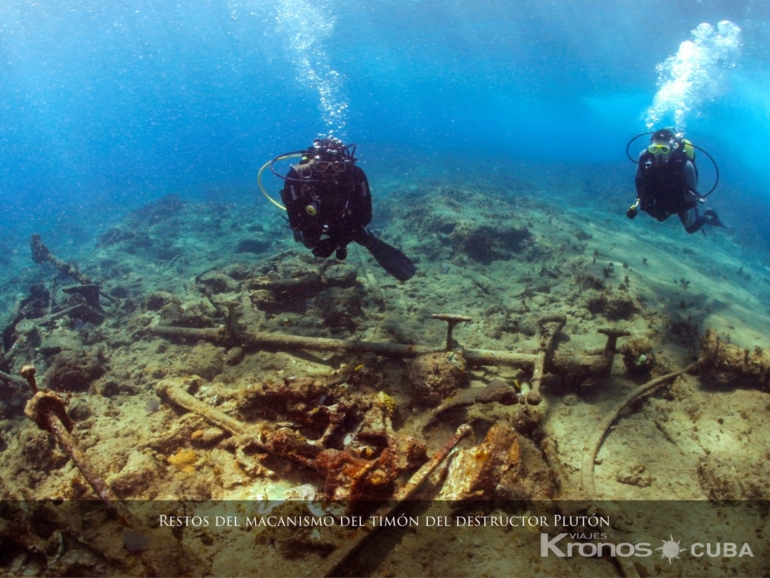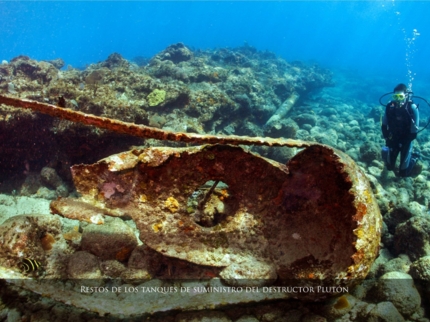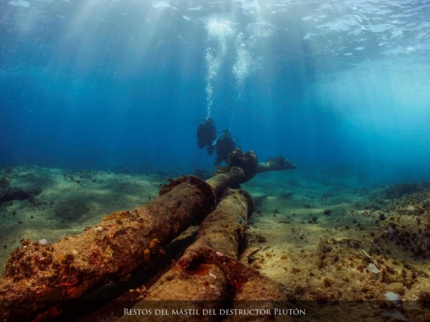General Information and Program Details
- Duration: 2 hrs
- Departure time: 09.00 hrs
- Tour guide: Yes
- Children are allowed: No
- Languages spoken: Spanish and English
- The boat is shared.
- No minimum number of divers is required for the excursion. Viajeskronos will reconfirm 48 hours before the departure of your tour. If the provider decides to cancel, for not meeting the minimum required amount of passengers, Viajeskronos will offer an alternative tour or fully refund cost of your trip.
- Transportation not included in the services of the diving excursions in Santiago de Cuba. The client must arrive at the Marina Marlín in Punta Gorda by his own means 30 minutes before the indicated time of the excursion.
- The excursion can be cancelled in an unexpected way if the general weather conditions and especially in the sea advise it. This does not imply any responsibility or penalty for the agency and the marina company offering the service. In principle we will try to change the date of the excursion for the following days when the conditions improve. If this is not possible, we will proceed to refund the total value of the excursion paid by the client previously.
- The client must present a valid diving certificate issued by an internationally recognized diving organization.
- The client must sign a waiver of responsibility for diving as a risky activity, releasing the agency and the marine company offering the service from any legal responsibility, before leaving for the excursion.
Scuba Diving in Wrecks of the Hispanic - Cuban and North American War of 1898. "DESTROYER PLUTON
Archaeological Park of the Natural and Cultural Underwater Heritage Battle of Santiago de Cuba Declared a National Monument in 2015.
General Description
One of the groups of the Subaquatic Natural and Cultural Heritage with the greatest historical significance in the country is the Archaeological Park of the Subaquatic Natural and Cultural Heritage Battle of Santiago de Cuba, declared a National Monument in 2015.
It is a true privilege to enjoy today the immersions in these wrecks of the 19th century in front of the Sierra Maestra mountain range, in warm, transparent waters, in an environment of spectacular beauty and with a name as suggestive as the Caribbean Sea.
The place is made up of seven archaeological sites (Playa Siboney, Las Cuatro Bocas, Playa Mar Verde, Rancho Cruz - Buey Cabón, Ensenada de Juan González, Aserradero and Playa La Mula), where the wrecks of five Spanish and two North American ships linked to the conflict lie, and objects belonging to the ships, including masts, ironwork, part of the artillery and projectiles.
It covers a territorial extension of some 64,824 nautical miles, equivalent to some 120,051 km along the coast from Siboney beach, belonging to the municipality of Santiago de Cuba, to "La Mula" beach, referring to the municipality of Guamá.
The area of the coastal strip of the province of Santiago de Cuba was the scene of one of the most transcendental naval events in the history of mankind. This naval battle, which culminated in the sinking of the fleet of Vice Admiral Pascual Cervera y Topete, put an end to Spanish colonial rule in America.
These sites are must-see for researchers, archaeologists, divers and tourists in general, not only because of their great historical value, but also because of the spectacularly beautiful surroundings where they have been found for more than a century of rest and biological activity, creating special ecosystems where the sessile fauna and marine flora have merged with the wrecks.
It is a privilege to know the universal history through these wrecks, witnesses of the events of this Naval War, undoubtedly a treasure of the Underwater Cultural Heritage, which is part not only of the History of Cuba, but of the Universal one.
ARCHAEOLOGICAL SITE: "JUAN GONZALEZ COVE" Shipwreck: "Plutón" destroyer.
- Municipality: Santiago de Cuba.
- Site: Buey Cabón settlement, west of Santiago de Cuba city.
- The "Plutón" shipwreck, is very close to the coast, easily identifiable from the shore by the number of fragments that the sea has deposited on the steep edge of the reef, where it would be defeated by enemy fire. Its remains are widely dispersed throughout the area that makes up the archaeological site, at a depth of between 2 and 6 meters. The site where he ran aground on July 3, 1898 is an irregular stretch of dogtooth coastline, about half a mile away, between Rancho Cruz cove to the east and Buey Cabón cove to the west, which opens out onto the southern Caribbean.
Historical background:
The "Plutón" was built, in the Clydebank Engineering & Shipbuilding Co. shipyard in the United Kingdom. In April 1897 it was launched seven months later, the machinery, armament and war arsenal were completed.
In 1898, the "Plutón", along with other destroyers, was ordered to join the squadron commanded by Vice Admiral Cervera, its mission was to go to Puerto Rico to defend Spanish colonial rule in the Caribbean.
On July 3, 1898, the "Pluto" was the last ship to leave the mouth of Santiago de Cuba Bay, but it was awaited at its departure by American ships, which did not hesitate to welcome it with a rain of projectiles.
Today, the remains of the ship, scattered over land and sea, make the archaeological site a truly special place for lovers of history and diving.
TECHNICAL CHARACTERISTICS OF THE VESSEL "Plutón":
- Name of the shipwreck: "Plutón".
- Flag: Spain.
- Date of commissioning: 12 February 1879.
- Class: furor.
- Type of ship: destroyers.
- Commander: Lieutenant "Pedro Vázquez".
- Crew members: 75 men.
- Shipyard: Clydebank Engineering & Shipbuilding Co., United Kingdom.
- Launch date: April 1897, completed on 4 November 1897
- Length: 69.79 meters.
- Beam: 6.80 meters.
- Strut: 4.20 metres.
- Draft: 3.00 meters.
- Type of bow: Running, with a small bridge about 15 m from the bow, with wind turbines distributed along the length, with two 75 mm "Nordenfelt" cannons at the bow and at the stern in rotating axial trusses. Two davits on both sides in the first third of the boat. Cable handrails along the whole row, from bow to stern, wooded with pipes screwed to the deck.
- Displacement: 380 tons.
- Maximum speed: 28 knots.
- Range at low power: 1000 miles (nautical).
- Type of machinery: 2 triple expansion steam engines.
- Type of power supply: Mineral coal - 96 tons.
- Power: 4000 - 7000 hp with forced draft.
- Boilers: 4 "Normand" boilers.
- Propulsion: 2 propellers.
- Mast: 1 mast with davit.
- Torpedo launchers: 2 sites (on deck).
- Large calibre artillery: 2 pieces.
- Maxims machine guns: 2 pieces.
Details of the excursion
- Diving services included: Basic diving equipment, compressed air tank, weight belt.
- You will have an internationally certified instructor-guide who will give you an informative briefing on the dive to be done.
- Boat that takes you from the diving center to the diving points (in principle, the dives that leave from the marina of Punta Gorda will be done by diving boat).
Diving center: Marina Marlin Punta Gorda
Output capacity: in 10 pax.
Frequency: 2 departures per day.
Distance to cover in the route (round trip): 30 km approximately.
Approximate duration of the tour (total): 2 hours approximately.
Degree of difficulty: Low.
VERY IMPORTANT NOTES:
For reasons of safety and protection of underwater heritage, clients should never directly touch the wreckage and should strictly follow the instructions given by the diving instructors.
It is mandatory for customers to present their official diving certification.
TIPS: • We recommend that the client can bring their own diving mask. • Recommended: light clothing, swimsuit, towels, sunglasses, hat, sunscreen and photographic camera. • The client can bring his complete diving equipment if he wants to. • We recommend that the client can bring his/her personal dive computer. • We recommend that the client can bring one or more bottles of mineral water to stay hydrated as well as light foods rich in protein or fruit.
BOOK SCUBA DIVING IN WRECKS OF THE HISPANIC - CUBAN AND NORTH AMERICAN WAR OF 1898. "DESTROYER PLUTON".
-
Collective diving tour (1 dive)Tour in diving boat with professional diving instructor service in several languages and 1 dive.1 Adult(Daily departures)Not departure in selected date








